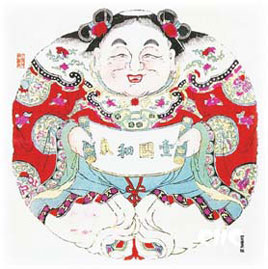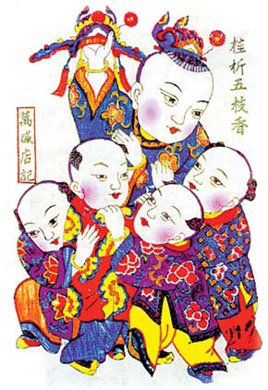|
|

Two of the leading styles for nianhua across the country - Taohuawu in Jiangsu (left) and Yangjiabu in Shandong (Below right). File photos |
Chinese people used to decorate their homes with nianhua (New Year pictures) during Spring Festival. They are usually placed on doors or walls, to prevent evil spirits and bring good luck to the family.
Woodprint nianhua paintings, one of the most distinctive wood-block art forms in China, are believed to have first appeared during the Tang Dynasty (AD 618-907).
The legend goes that Li Shimin, founder of the Tang Dynasty, often had nightmares about ghosts. In order to exorcise the bad dreams, the emperor ordered two of his generals, Qin Qiong and Yuchi Jingde, to guard the door of his bedroom all night.
As it was impossible for the two generals to guard him every night, the emperor asked artists to paint their portraits and paste them on the door, thus creating the "door gods" which have become the major subjects of many woodcut pictures.
However, since the art form was not highly regarded, it was not well documented in books of the time.
A piece of nianhua art comes to life after many steps, including drawing and tracing, block engraving, printing, and coloring.
"For the most complex nianhua works there are nine colors. For the nine-color picture, a craftsman has to use woodblocks of different colors and print the picture nine times," explains Huo Xiuying, a nianhua artist in Tianjin.
"For centuries, the style, themes, and production techniques of Chinese nianhua have evolved dramatically," says Zhang Wenbiao, a Shanghai-based collector who has accumulated over 10,000 old nianhua works created by artisans from early Qing Dynasty to modern times.
The New Year woodprint painting style has waned in popularity in modern times. Just a few workshops remain, Zhang says.
There are several leading production bases for nianhua across the country - Yangliuqing in Tianjin, Mianzhu in Sichuan province, Wuqiang in Hebei province, Zhuxianzhen in Henan province, Yangjiabu Village near the eastern city of Weifang, Shandong province, and Taohuawu in Jiangsu province.
In Zhuxian township of Henan province and Fengxiang county of Shaanxi province, only a handful of folk artists still engage in nianhua production.
Of all these, Yangliuqing New Year pictures are generally considered the best-preserved, with the largest stock of high quality vintage woodblocks and sketches by artisans from centuries ago.
Yangliuqing nianhua originated in Yangliuqing, a western suburb of Tianjin, in the early 17th century.
The traditional works were then and are still made mainly through a combination of woodblock and hand painting.
Ingenious and unique in composition, fresh and smooth in line, vivid and life-like in form, and strong and rich in essence, Yangliuqing nianhua generally features ancient beauties, lovely children, folk customs, or stories from classical operas, myths and legends.
Yangliuqing nianhua enjoyed its heyday in the Ming (1368-1644) and early Qing (1644-1911) dynasties.
From the very beginning, Yangliuqing nianhua art catered to the tastes of different social classes, from ordinary farmers and city dwellers, to emperors of the Ming and Qing courts.
"The richness of sub-genres and varieties of the folk art itself attracted many ancient intellectuals to participate in the creation of nianhua art by contributing sketches of figures, landscapes, birds and flowers that are more refined than most of those produced by craftsmen of Yangliuqing pictures who only received training in the folk art's skills," explains Wang Shucun, a Beijing-based collector of old nianhua works.
In the reign of Emperor Qianlong in the Qing Dynasty, of the 30 villages in Yangliuqing township, there were over 300 art studios with at least 3,000 folk artisans engaged in nianhua production, local records show.
And on the three main streets of the township proper, there were hundreds of art shops, selling nianhua and other folk art works in at least 2,000 varieties, catering to the demands from consumers in North and Northeast China provinces.

Over the years the traditional folk art has been on the verge of extinction. The paintings were rejected as a form of superstition after the founding of New China in 1949, but in the countryside villagers still bought them to decorate their homes.
"It was in the past two decades with the fast pace of globalization and economic growth that the art began disappearing at a record rate, falling nearly into extinction," says Huo Qingyou, a master nianhua artist in Yangliuqing.
To widen profit margins, new techniques such as serigraphs and offset lithography are used to enhance the output of some nianhua studios.
However, much to Huo Qingyou's relief, hand-made artworks earn much higher prices on the markets.
"This is a confirmation of the original ideas and hard work of the folk artist," Huo claims.
In the face of fierce competition from printing houses with mass production technologies and better marketing skills based in Zhejiang province's Yiwu, many small studios in Yangliuqing have reportedly suffered and some have closed down.
There are just 39 nianhua studios operating in the township and they are responsible for keeping the ancient art alive.
(China Daily 01/30/2009 page7)
|

